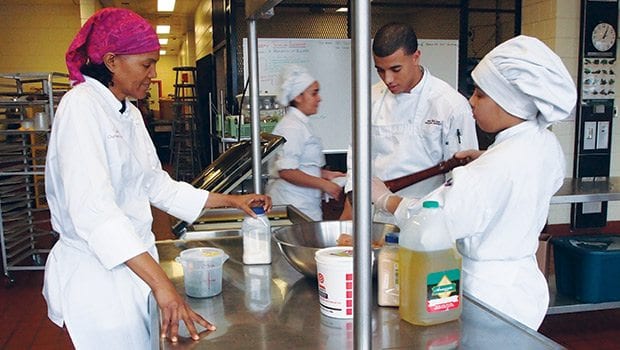
Hopes are high for Boston’s long-struggling voc tech high school, Madison Park Technical Vocational High School. Kevin McCaskill, who took the helm as executive director of Madison Park in April 2015, says the school is on track to turnaround.
Madison Park has a troubled history: Former Mayor Thomas Menino called for its overhaul in 2012. The school was declared underperforming in both 2014 and 2015. School Superintendent Tommy Chang selected Madison Park as the launch site for high school redesigns in his 100-Day Plan.
In December 2015, the state gave Madison Park a Level 4 designation, based on its record of poor MCAS scores, low graduation rates and high dropout rates. It has three years to improve. Should it fallfurther, to Level 5, the state will take it over. McCaskill says that will not happen.
“This school is going to be successful,” McCaskill said. “No doubt in our minds about that.”
This February, the school’s 13-member stakeholder group — which includes teacher, parent, student, administrator and city and state school department representation — submitted to Superintendent Chang a set of recommendations on the turnaround plan. While a blueprint is pending, Madison Park administrators have initiated some remedial action.
Bob Marshall, a Friends of Madison Park member who taught at the school for 28 years, said that the work is off to a promising start, but large change will take several years.
“It’s a large shift to turn a ship around,” Marshall said. “They’ve started off on good footing.”
Sense of purpose
School year 2014-2015 began chaotically: Students were without schedules and room assignments for weeks, teachers were still being hired and the principal resigned in early September when it came to light that she was not certified in Massachusetts. After four days without classes, students walked out in protest.
McCaskill outlined several changes that focus on providing students with a sense of consistency and direction, and faith in leadership. Fixes include using common lesson plans, protocols and structures across the academic and vocational programs. Other efforts under exploration: Show students how the different areas of their curriculum work toward a coherent and purposeful outcome. This includes figuring out how to integrate core academics with vocational subjects: For instance, the role of chemistry in the cosmetology, culinary arts and dental programs.
Administrators also are seeking to create more dual-enrollment programs with higher education institutions, which allow students to earn college credit while in high school, McCaskill said.
Here to stay
Another step: Reduce turnover. The senior class has experienced at least four different headmasters already, McCaskill said. Now, he says the students are starting to believe that the latest administrators are here to stay.
“They’re beginning to see that this isn’t just temporary,” McCaskill said. “There’s a commitment here that this is not a one-year deal and folks are out the door. We’re going to lay down roots and move this school forward.”
As part of the turnaround, teachers are required to reapply for their jobs. In their February 2016 letter, school stakeholders advocated for a turnaround model that would allow the school to retain as many of the effective current staff as possible — as opposed to following a model that requires that a specific percent of staff be new — to offset reduce instability. The letter called for more staff professional development.
Madison Park administrators will begin hiring in a few weeks and have received several inquiries so far, McCaskill said.
Pride and climate
McCaskill says he wants students to feel connected to and welcomed at Madison Park. Simple steps include reminding teachers to greet students entering the school or their classrooms and physically brightening up the building with college banners and murals that depict post-high school life paths. Several murals were begun last fall.
McCaskill said there is a clear change among the students since the time he visited last May and today.
“They’re different. They feel comfortable in school,” he said.
Another step: meeting student academic needs that extend past the school day. Headmaster Shawn Shackelford, who also is new, implemented after-school and Saturday tutorial programs this year.
Enrollment and funding
Administrators are reaching out to counselors and administrators at middle and K-8 schools to spread the word about what Madison Park offers and encourage more rising high school students to come.
Boosting enrollment will be important, in part, for securing funding, because the school department provides per-student funding. The school has been under-enrolled for the past several years, according to McCaskill. Getting to capacity would allow it to offer more programs, he said.
Madison Park has been long underfunded, according to Marshall. Other vocational schools in the state have budgets that are greater by tens of thousands of dollars, and while those schools may have shop classes run by four teachers, Madison Park has similar classes with only one teacher and one paraprofessional, he said.
Madison Park’s study body currently comprises many students who may need more resources: according to state Department of Elementary and Secondary Education figures, in School Year 2015-2016, more than 32 percent of students are English language learners, more than 37 percent have disabilities, nearly 58 percent are economically disadvantaged and approximately 85 percent are high needs.
“Madison’s got a lot of potential. As long as they give them the resources that they need,” Marshall said. “If they don’t give Madison the resources it deserves, then the school is going to fail.”






